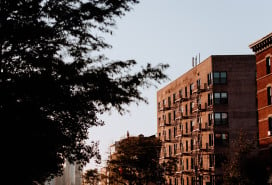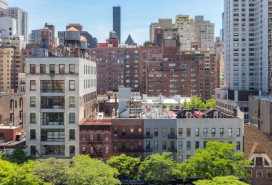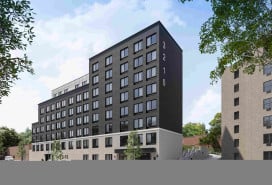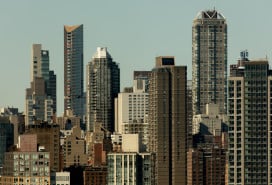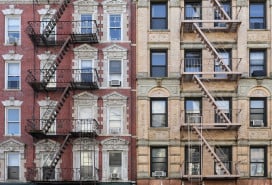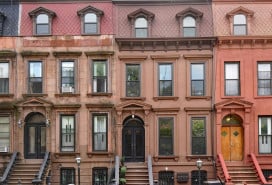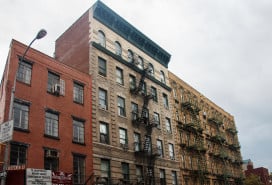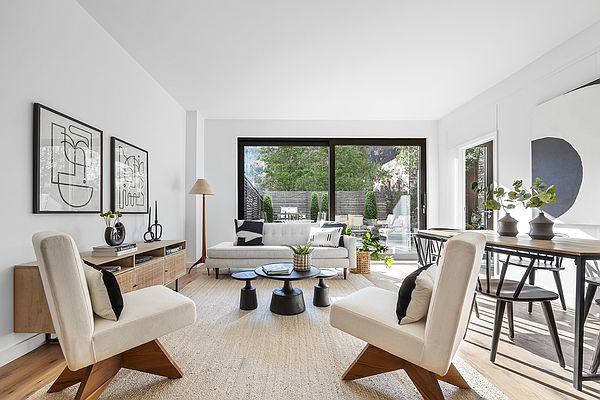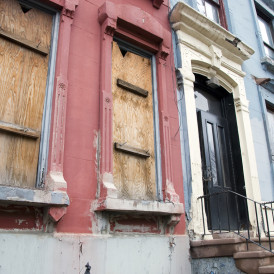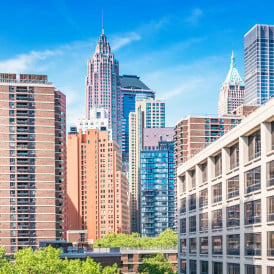Condos in the burbs? For some buyers, the suburban dream is not a house
- Suburban home buyers on a budget face low inventory, high prices, and dated interiors
- With a smaller footprint, condos are a less expensive way to live the suburban lifestyle
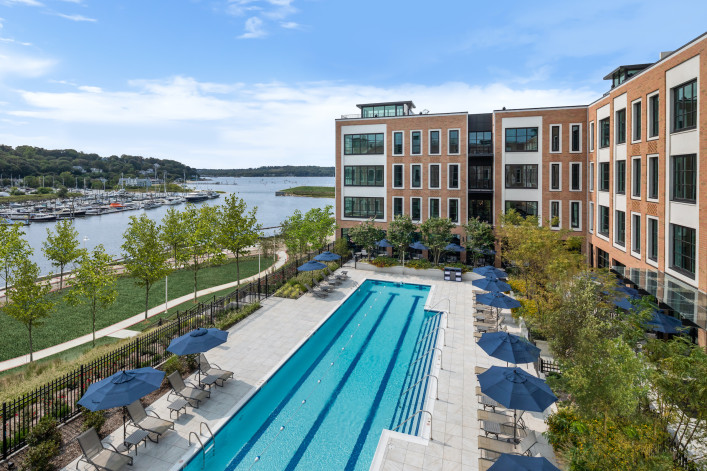
A heated swimming pool at The Beacon, a condo development in Glen Cove, NY, on the edge of Hempstead Harbor.
For some New Yorkers heading outside the city to buy a place of their own, the suburban dream is a condo with a shared roof deck, not a house and a yard.
That’s because the fantasy of owning a house in the suburbs around New York City doesn’t always line up with reality. Listings for suburban houses fell over the past two years—a result of owners with mortgages in the 3 to 4 percent range unwilling to put their properties on the market if it means borrowing at higher rates. Buyers have a hard time uncovering houses in their price range, and when they do find places, sometimes the houses are too dated and costly to upgrade.
Then there are other buyers who are making a beeline for condos. They don’t want the headache and expense of maintaining a house and a yard, even if they want the suburban lifestyle—easy access to New Jersey, Long Island, Westchester, and Connecticut beaches, parks, and golf courses, for example.
Some are in a transitional phase—they want to live in a condo now and plan to rent or sell it later. For them, convenience and luxury are the goals.
Condos are less prevalent in the suburbs, but there’s strong demand for them, developers tell Brick. What’s more, new condo developments, which offer access to the usual amenities like gyms and pools, can also have perks many buyers can’t afford in the city, like waterfront parks and expansive water views. And the biggest draw of all: Prices for new suburban condos are lower than prices for new suburban houses and new condos in NYC.
It's not an apples-to-apples comparison since the report is tracking resales, but according to the Elliman Report, the median sales price for condos on Long Island was $430,000, compared to the median sales price for single-family houses of $699,000. The median sales price for Manhattan condos in the second quarter was $1,732,500, and for Brooklyn condos, it was $1,085,000
Stretching your dollars in the suburbs
Harjot Kaur, an agent at Keller Williams NYC, works with lots of NYC buyers heading to the suburbs. There’s often a misunderstanding of how far a buyer’s dollars will stretch and what kind of house they can get, she said.
Some buyers assume that with a budget of $700,000 or $800,000, they can have their pick of houses. “But then you start looking and realize houses in this price range are not updated, and a two-bedroom condo with a NYC view is a better deal,” she said.
Last year, one of her clients was looking for a house within 30 minutes of Jersey City with a budget of $500,000.
They were recently engaged and really wanted a single-family house, even a fixer-upper, Kaur said.
“But it is really tough to find something reasonable in that budget less than an hour from the city, plus a first-time buyer putting 5 percent down can’t really compete with buyers who can go over ask.” And they risk the dreaded appraisal gap, when the appraised value falls short of the agreed-up sales price. The burden falls on buyers to make up the difference if they want to stay competitive.
Her buyer “started flirting with the idea of a condo,” first hunting in Hudson County, New Jersey, eventually landing in Rahway, in Kaur’s very own 2008 condo building, which was recently renovated. “They got one of the last units for sale,” she said, landing a 1,216-square-foot, two bedroom with a washer and dryer, doorman, and shared outdoor space for $415,000.
For another of her clients, she created a detailed spreadsheet, which she shared with Brick. It compares two-bedroom listings in Brooklyn, Manhattan, and Hudson County, in the $800,000-to-$1.2 million price range. The Manhattan apartments on her list were about 1,000 square feet and mostly around $1,100 per square foot.
The client was interested in Hoboken, Jersey City, and North Bergen, and she rounded up listings that were much larger than their NYC counterparts, about 1,100 to 1,550 square feet, with prices ranging from $804 to $995 per square foot.
For example, a two bedroom, two bath in Hoboken in a 2019 building has JennAir appliances, quartz countertops and a 13.5-foot breakfast bar. It is asking $1,050,000.
In another situation, Kaur worked with a pair of longtime New Yorkers who wanted more space and were “fed up with paying for parking. They didn’t care about a yard, and wanted a place that was modern and updated, but the houses in their budget didn’t match what they wanted.” A three bedroom in a Jersey City Heights duplex for $800,000, with a private rooftop and parking included, was the solution.
Taking the leap
Leaving NYC for the suburbs is a big move, both financially and emotionally, Kaur noted.
For the buyers she works with, “if they have one or two friends in an area, that’s where they will prioritize their search. It’s always tough to leave their NYC social circle. They can rebuild it if they have two friends who provide some comfort and familiarity,” she said.
“These friends talk to them about walking their dog along the pier, or having extra space for their parents to visit, or a real nursery. It puts an image in their mind and they want that for themselves.”
New appreciation for the suburbs
As a result of the pandemic, the suburban housing market “became a competitor to the city,” said Jonathan Miller, president of appraisal firm Miller Samuel and author of the Elliman Report.
The pandemic accelerated outbound migration from the city to the suburbs—it didn’t create it, Miller said. Many New Yorkers who had planned on leaving the city someday sped up their timelines by six or seven years once the city went into lockdown, he added.
Remote work has also changed the way New Yorkers live, enabling workers to embrace living farther from the city. If you don’t need to come into Manhattan every day, then a longer commute is more tolerable.
“As a result, we saw demand explode for single-family houses in the suburbs,” Miller said.
Condos in pricey destinations
As demand for the suburbs increases, “we’ve seen new condo properties come into places like Greenwich and Hamptons. They tend to skew toward luxury prices, but nowhere near what you see for houses in those areas,” Miller said.
According to the Elliman Report, the median sales price for condos in the Hamptons in the second quarter was $1,023,500, compared to $1,900,000 for single-family houses.
Greenwich, Connecticut, had a median sales price in the first quarter of $1,140,000 for condos, compared to $3,800,000 for single-family houses. (The Elliman Report recently ceased tracking Connecticut real estate markets.)


NYC-style condos in Westchester
An upscale, urban design was the goal at The Daymark Condo in Sleepy Hollow, NY, designed by architecture firm COOKFOX, known for its many projects in NYC. The development is expected to open its doors in fall 2025.
“We wanted the same building you would have in Tribeca,” said Peter Chavkin, managing member of Biddle Real Estate Ventures, one of the master developers of the project with PCD Development. They were aiming for the “same finishes and same amenities” found in NYC condos, he said.
Prices range from just over $1 million to just over $4.5 million at The Daymark, which has 100 units with a mix of one- to three-bedroom layouts as well as townhouse-style residences. Monthly common charges range from $864 for a one bedroom plus den to $1,994 for a three bedroom plus den.
Amenities—like a co-working lounge, outdoor pool, fitness center, landscaped courtyards, and roof terrace—are also comparable to what you would find at a “high-end condo building” in NYC.
The Daymark is over 60 percent sold since launching sales in July 2023.
“Based on demand we’ve raised prices a few times," Chavkin said. He noted that the success was somewhat astonishing: “If we talked 10 years ago and I said that I was trying to sell $4.5 million condos, you would have told me I was crazy.”
A perch on the Hudson River
While the interior has an urban design, the location on the Hudson River is bucolic, and the river view is framed by the Mario M. Cuomo bridge.
The Daymark is part of a $1 billion, mixed-use development called Edge-on-Hudson, and just a couple of decades ago, this stretch of Hudson was dominated by industry. The site of The Daymark is where General Motors assembled cars from 1900 until 1996.
Edge-on-Hudson will eventually include 1,177 townhomes, condos, and rental apartments; a 140-room boutique hotel; 135,000 square feet of retail space; and 35,000 square feet of office space, plus more than 16 acres of new parkland with a waterfront promenade that is open to the public. Construction is underway on a 30,000-square-foot DeCicco & Son's market across the street from The Daymark, which will also be the site of a waterfront restaurant.
“When GM was operating a factory here, access to the waterfront was not open to the public,” he said, adding that the entire waterfront park was funded and developed by Edge-on-Hudson and dedicated to the Village of Sleepy Hollow.
Buyers touring The Daymark are typically weighing whether they want to buy new construction, stay in their current home and renovate it, or move to another, single-family home, he said. The Daymark wins over buyers willing to downsize to a single floor.
“Some will say, ‘I don’t care about less space, I want the river view,’” he said.
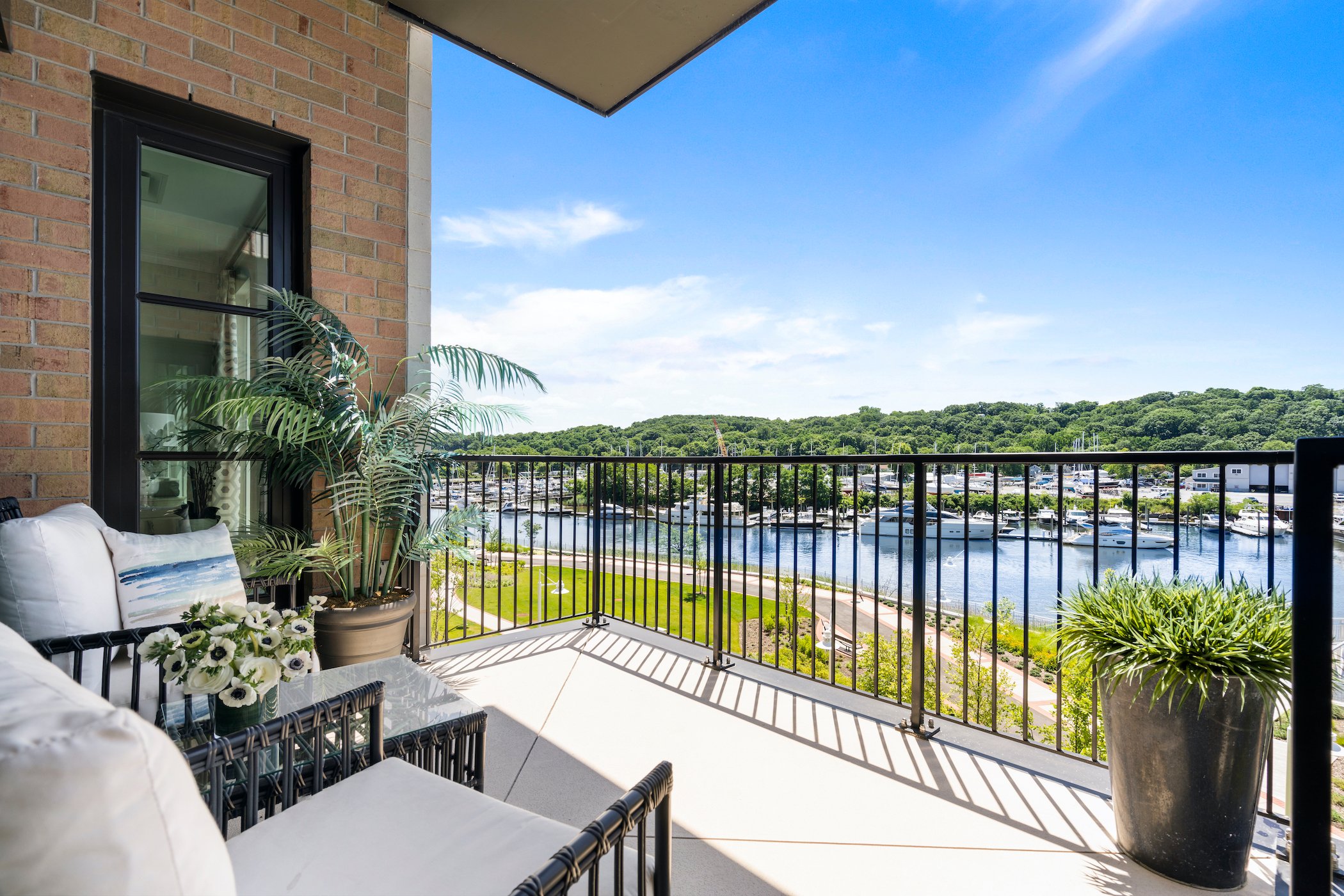
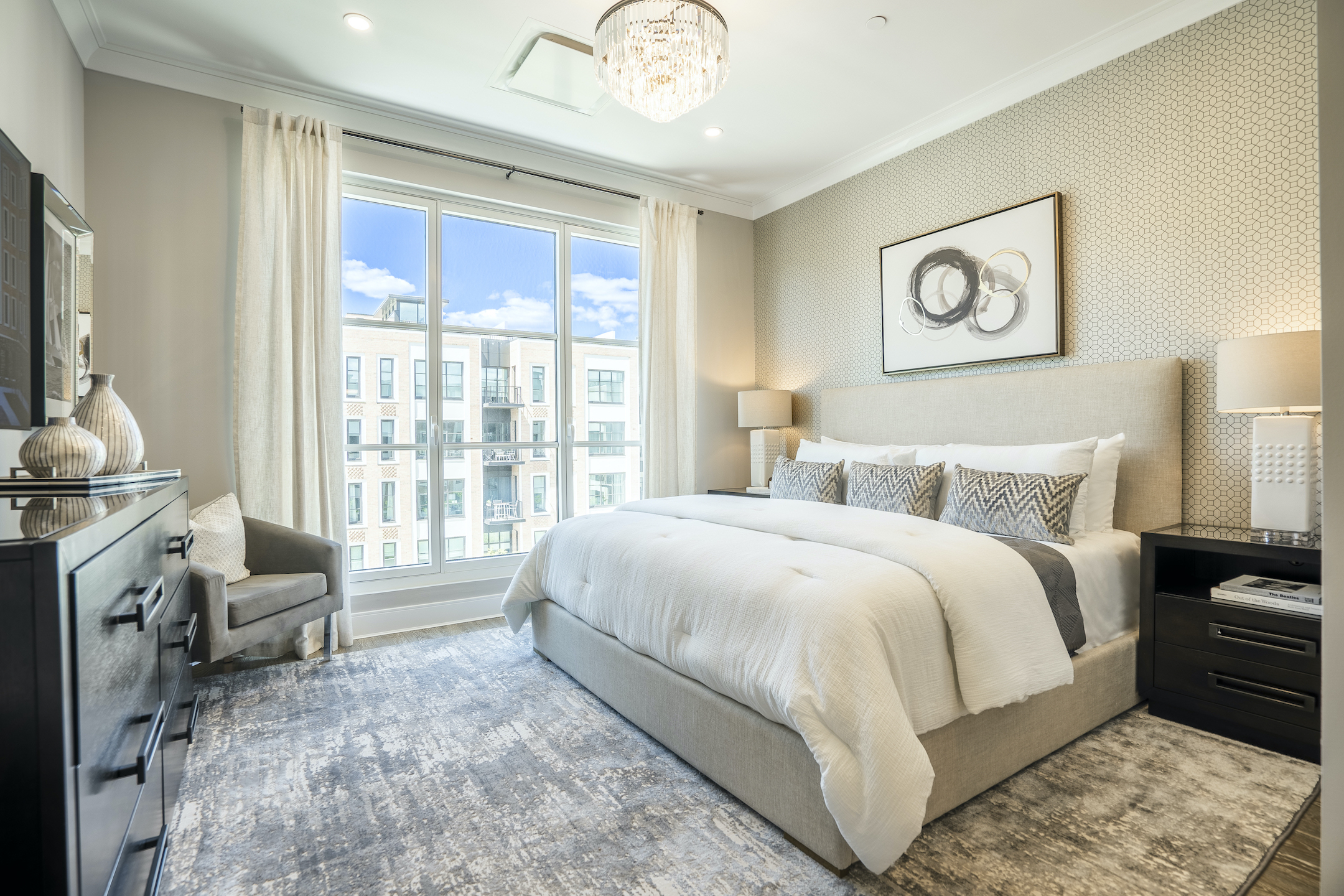
Overlooking a harbor on the North Shore
A built-in community is part of the draw for buyers at The Beacon, part of the Garvies Point development in Glen Cove, NY, on Long Island’s North Shore. The development also includes Harbor Landing, which is a rental property.
The development, in a 56-acre waterfront area, features a mile-long esplanade that’s open to the public. Next door is a nature preserve with miles of trails and walkways. The area overlooks marinas at the edge of Hempstead Harbor, which leads into the Long Island Sound.
Prices for condos at The Beacon range from $800,000 to $2.9 million, averaging about $950 per square foot. Monthly common charges range from $870-$2,800.
Joe Graziose, executive vice president of residential development and construction for RXR, the developer of the project, said the condo portion is 84 percent sold since sales launched in 2017.
There’s strong demand for condos in Nassau County, Graziose said. Another RXR project, the Ritz-Carlton Residences in North Hills just signed the last contract for its 230 units.
But condos are a fraction of the housing market in Nassau. A search on Zillow turned up listings for approximately 2,000 single family houses and 300 condos in Nassau County. Listings are more prevalent in Westchester County, where there are about 930 single-family houses on the market, and 600 condos.
Advantages and disadvantages
Living on this part of the North Shore is tricky for NYC commuters and drivers accessing other parts of Long Island. The area is a peninsula, and to get to the highway requires a drive of 30 minutes on congested roads. It’s also about an hour to Penn Station via the Long Island Rail Road. “It’s not for everyone to live this far north,” Graziose acknowledged.
But taxes, a perennial headache for suburban owners, are lower for condos than houses. The suburban counties around NYC have the highest median property taxes with bills exceeding $10,000 a year. Owners of large properties can pay two or three times that amount.
Communal living in the burbs
The communal quality of condo-style living is winning over suburban buyers, including those who are widowed or empty nesters, or families with young children. They are discovering the benefits of being able to be social right in your own building, Graziose said.
“They find it interesting and enjoyable,” he said. Building amenities include a fitness center, restaurant, resident’s lounge, doorman, concierge. Outside is a heated swimming pool, garden, children’s playground, and farmer’s market.
“There is such a shortage of housing on Long Island, and a shortage of condos for baby boomers,” he noted. Condos give buyers the ability to stay active in their community without having to care for a lawn or manage roof repairs, for example.
“In a condo, you’re not waking up and thinking of any of that,” he said. But with 20,000 square feet of amenity space at The Beacon, “you have everything you would have in your big, suburban house, except you share it.”
You Might Also Like

